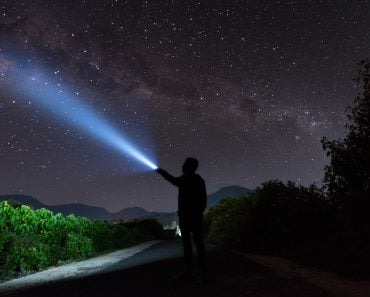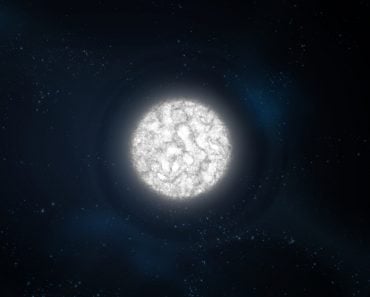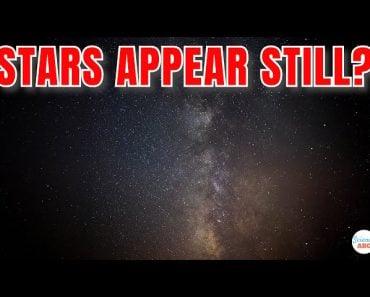Table of Contents (click to expand)
Yes, there is a size limit to how big a star can grow. The accepted upper limit of a star’s mass is approximately 300 M (M = Solar Mass; 1 Solar Mass = the mass of the Sun), but the largest star recorded to date is named R136a1, measuring in at 265 M, giving it a total volume that is 27,000 times greater than our Sun.
When you look up into the night sky, provided you’re not in the heart of a city, there is a good chance that you will be dazzled by thousands of tiny points of light, stars from trillions of miles away. We also owe our very existence to the perfect distance of our home star, an object more than 1 million times larger than our planet. More specifically, 1.3 million Earths could fit inside the Sun, and remember, we have over 7.4 billion people living on this planet.
With that in mind, it’s easy to think that the Sun is an incredibly massive object, and its size is beyond our comprehension. However, you may be disappointed to learn that in comparison to many other types of stars and celestial objects out there in the universe, the Sun is “puny”. Sure, our sun is not the smallest type of star (that title belongs to red dwarfs), but it is also FAR from the largest.

In a world where superlatives are sought after, this brings up an important question… how big can a star get?
Short Answer: The accepted upper limit of a star’s mass is approximately 300 M (M = Solar Mass; 1 Solar Mass = the mass of the Sun), but the largest star recorded to date is named R136a1, measuring in at 265 M, giving it a total volume that is 27,000 times greater than our Sun.
Recommended Video for you:
The Science Of Stars
At the birth of any star, there are two key forces at play – the gravitational pull from the rotating gas cloud (which will eventually form the proto-star) and the electromagnetic radiation pressure pushing outward. The standing theory for many years was that a star wouldn’t be able to grow much larger than 20 Solar Masses before the outward force of the radiation would cause the gas cloud to explode or disperse, basically pushing away the matter that fed the star’s growth in the first place. However, scientists were baffled when they observed stars that were much larger, some as much as 120x the Solar Mass of the Sun. It didn’t make sense, given what they understood about the pressure balance during star formation, but there is another explanation.
Through computer simulations and observations of other stars, researchers found that this push-pull relationship is not equal on every surface of the star. In other words, there were some areas where the gas cloud was being pulled in to grow and expand the star, while other areas were acting as release valves, kicking out huge amounts of electromagnetic radiation. Essentially, the same accretion process that low-mass stars use was also able to form high-mass stars. In some cases, it is believed that smaller stars can form near high-mass stars and smash into their larger neighbors, speeding up this process of stellar growth.
Now that you have some idea of how massive stars can be born (and survive their adolescent years without blowing up), it’s time to understand what sorts of sizes we are dealing with…
Comparison Of Our Sun With Other Stars
As mentioned above, let’s consider our Sun, with a Solar Mass of 1, as the base point of stars. Smaller stars like brown and red dwarfs do exist, but we’re interested in going up in size! Our 1M Star has a radius of 432,450 miles and a total volume of 1.4 x 1027 cubic meters. After that, we have…
The rest of the main sequence stars:
The majority of stars in our galaxy and the rest of the universe are in the main sequence, meaning that they have reached a type of static equilibrium between radiation pushing out and gravity pulling in. They are converting hydrogen into helium and releasing huge amounts of energy as a result. The bottom range of these main sequence stars is about .08 times the mass of the Sun, and the high end can reach up to 100 times the mass of the Sun.
Main sequence stars usually stay in that designation for about 5 billion years, and the larger they are, the hotter they are, and therefore the brighter they are. The Sun is in the middle of this band of stars, with many stars being larger and smaller, although similarly stable. The main sequence stars include yellow dwarfs, blue dwarfs and red dwarfs.

Most of the most famous stars with names you recognize belong to the main sequence, such as Vega, Sirius A, Alpha Centauri, and Bellatrix.
Above the Main Sequence:
Red Giants, Yellow Giants and Orange Giants are the next step up once a star leaves the main sequence. Once the regular hydrogen to helium fusion process stops, the shell of hydrogen around the core of the star ignites and suddenly swells the size incredibly, often 100 times its size during its main sequence existence. This period can last for roughly 100 million years, at which point they will collapse, typically resulting in a white dwarf star. No more fusion will occur, but it will take hundreds of billions of years for those stars to eventually reach the background temperature of the universe. Some of the famous giants that we are familiar with on Earth are Arcturus and Aldebaran (red giants), and Pollux (orange giant).
Supergiants are a slightly different story, often starting off at dozens of times more than the mass of the Sun, but given their enormous size, they consume fuel very quickly, and therefore, have earned the reputation to “live fast and die young”. Supergiants come in many shapes and temperatures – Blue, Red, White and Yellow. Ranging from blue supergiants, with a mass of about 20x the Sun (temperature; 20,000-50,000 Kelvin), down to the rare yellow supergiants, which can actually have a mass of less than the Sun, but far greater luminosity (temperature; 4,000-7000 Kelvin). Some of the most well-known supergiants in our neck of the woods are Rigel (blue supergiant), and Antares A and Mu Cephei (Red Supergiants). When these supergiants reach the end of their life, they tend to “go supernova” and leave black holes behind.
Hypergiants are the kings of the stellar universe, and while they weren’t theoretically supposed to exist, the discovery of these monster stars in recent years has thrilled astronomers. However, as with the supergiants, their lives are very short. While the smallest red dwarf stars could theoretically continue burning for TRILLIONS of years, hypergiants will explode in dramatic fashion after only a few million – the blink of an eye in cosmic terms.
With incredible lumosity (~4 million times brighter than the Sun), these stars are hugely massive (130M-315M), and are the largest stars that have been discovered. Astronomers doubt there can be anything bigger, as these already seem to edge past the point of physical impossibility. Some of the most famous hypergiant stars are the Pistol Star (blue hypergiant) and VY Canis Majoris (Red hypergiant, and previously considered the largest star ever discovered).
Finally, we reach the top spot – the largest hypergiant star discovered to date…. Drumroll, please….
R136a1 – The Most Massive Star
Located in the Tarantula Nebula of the Large Magellanic Cloud, this star has been shining for approximately 1.7 million years and has already undergone significant mass loss due to stellar wind. While the present solar mass appears to be approximately 265M, backdating the evolution of the star suggests that it was between 315 and 325 M when it first started to shine!

And there it is, ladies and gentleman, the largest star we’ve found thus far, and likely the high end of the range for any star we’re likely to find in the future.













